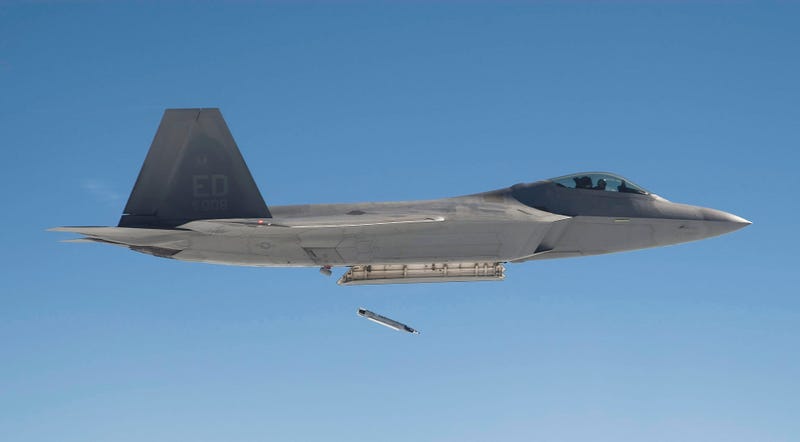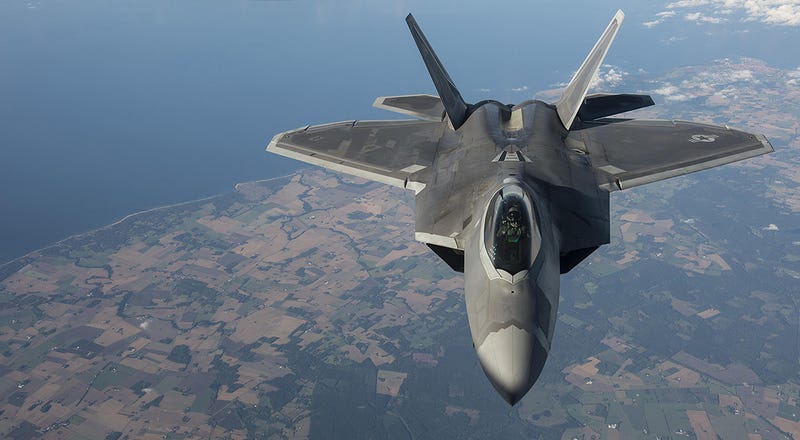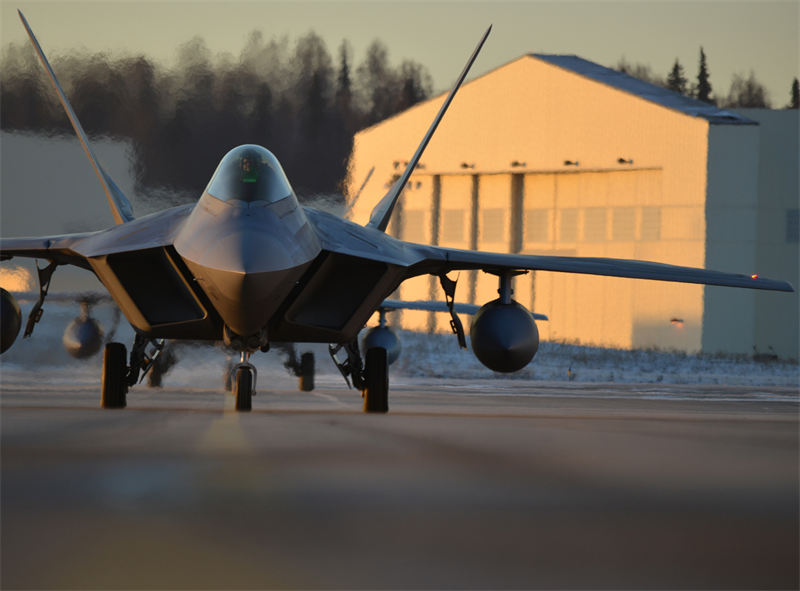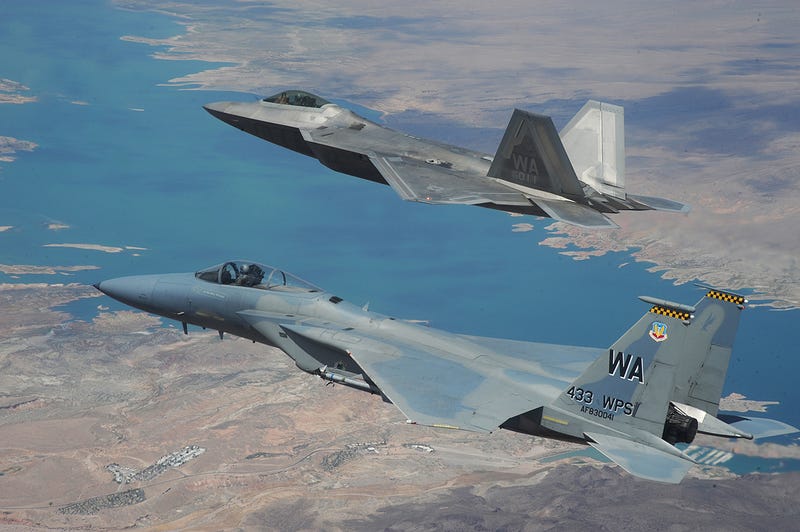Jura you get that great pic from this article that just came out yesterday?
As if they suddenly came to an epiphany, the United States Air Force brass is now admitting what many of us have been screaming about for so long: We didn’t build nearly enough F-22s, and the F-35 cannot simply pick up the slack. So why aren’t those who pushed so hard to cancel the F-22 program being held accountable?
By the mid 2000s, the F-22 was finally entering the fray as the world’s first true stealth fighter, offering a quantum leap in capability and performance when compared with anything else on the battlefield. It was a thoroughbred weapon system meant to shape the battlefield by vanquishing anything in the skies and neutering enemy air defenses, so that less capable combat aircraft could survive over the battle space. It was a high-end door kicker, the ultimate “anti-access” fighter.
At the same time that the
Defense Secretary Robert Gates, of both the Bush and Obama Administrations, was calling for the F-22’s demise. This was said to be due to the aircraft cost and use as “only” an air-to-air, destruction of enemy air defense, and deep strike platform.
Gates’s push for the Raptor’s demise came at the same time as the cost of examples of the jet were rapidly dropping. For the last batch of 60 of the super-fighters,
, which is pretty close to the cost of an “affordable” F-35A today – at a time when a similar number of F-35s have been built as F-22s, about 165 compared to the F-22’s 187.
Costs were slated to have continued to drop if another lot of about 53 jets were built to meet the Air Force’s stated minimum fleet size requirement of 243 airframes. But it never happened.
Instead the F-22 was cast off and all of the USAF’s fighter chips were put into the very much unproven F-35 bucket. Gates justified chopping the F-22 as he wanted aircraft to “fight the wars we are in today, and the scenarios we are most likely to face in the years ahead.” Considering air superiority and destruction of enemy air defenses is an absolute must for any conflict (aside for ones with totally permissible airspace), this was a very near-sighted evaluation, and as it turns out, prediction of the future.
To sustain U.S. air superiority, I am committed to building a fifth generation tactical fighter capability that can be produced in quantity at sustainable cost. Therefore I will recommend increasing the buy of the F-35 Joint Strike Fighter.
A misleading statement if there ever was one, as it’s impossible to build something in quantity at a sustainable cost when you’re not willing to build it in great enough numbers so that a sustainable cost is achievable. It’s a bit of a chicken-and-egg scenario, but at some point, the costs eventually balance out.
For the F-22, that point was rapidly approaching.
The F-22 was by
on the verge of a cost breakthrough that would have sent its unit cost plunging well below the $100 million line. Gates later said:
We have fulfilled the program. It’s not like we’re killing the F-22. We will have 187 of them... The military advice that I got was that there is no military requirement for numbers of F-22 beyond 187.
Considering that the minimum the
, this statement seems less than true. And that number was last ditch compromise, the real bottom-line fleet size the USAF required of the F-22 was around 339 jets, which itself was dropped drastically from the original number of around 750 jets originally envisioned. At 339 examples it was hoped that the F-15C/D force could have been retired.
Yet Gates was not alone in the push to cancel the F-22. The Bush administration was guilty of it too, although they were able to punt the final decision to the Obama administration, who demanded it be cancelled with a sharp veto threat.
Key Congressional figures like Senator John McCain also wanted the Raptor line shutdown. Their justifications ranged from the program’s expense, which was largely sunk costs for research and development over the aircraft’s 30-year gestation period, to statements proclaiming that China would not unveil a stealth fighter until late in the next decade, with no chance of it being operational until the mid to late 2020s. Today,
, the first one, the J-20, getting airborne well before the last F-22 even left the production floor. The timing of the J-20’s first flight also occurred while Secretary Gates was in Beijing meeting with top-level government officials.
For F-22 supporters it was an unwanted vindication.
Another common argument against the F-22 was that the idea of America meeting Russian, or any near-peer state fighter aircraft, head-on in battle was a relic of the Cold War, and had no place in 21st century. Because of this, less potent, multi-role platforms were more of a necessity. Fast forward a half decade, and that statement is far from accurate. In fact, the
The F-22 has also
, itself attacking many targets with great precision
Back in the Gates years, naysayers, like embattled Air Force Chief of Staff General Michael Mosley and Secretary of the Air Force Michael Wayne, both supporters of the F-22, were gotten rid of.
, stating that the shutdown of the F-22 program “will prove to be one of the most strategically dislocated decisions made over the last 20 to 25 years.”
He also said that follow-on batches of F-22s were quoted as costing well below $90 million per copy fly-away cost, which is about 25 percent less than the cost of an F-35A today.
Nowadays it seems that everyone laments the premature F-22 line shutdown, from late-to-the-scene defense commentators to those at the very top of the USAF, including Air Combat Command chief Herbert “Hawk” Carlisle, whoe was quoted in
“We don’t have enough F-22s, that’s a fact of life. We didn’t buy enough; we don’t have enough.” However, the Air Force is going to make do with the Raptors it does have, Carlisle said. “You’re going to need the Raptors” for a high-end fight, he said. “So you’re still going to have to do that and we’re going to do it with the 180 or so F-22s we have.”
Because only 187 F-22s were built, with only about 125 of the jets setup for assignment to combat units at any given time,
. As such, the F-15C/D force, which less than a decade ago was
, has had to stay online to supplement the relatively tiny F-22 force.
had said in The National Interest most recently:





